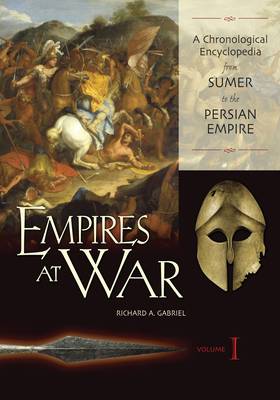
- Afhalen na 1 uur in een winkel met voorraad
- Gratis thuislevering in België vanaf € 30
- Ruim aanbod met 7 miljoen producten
- Afhalen na 1 uur in een winkel met voorraad
- Gratis thuislevering in België vanaf € 30
- Ruim aanbod met 7 miljoen producten
Omschrijving
For more than 5,000 years, massive empires have met on the battlefield to determine the future course of world history. Ranging from Sumer, the world's first imperial state, to the fall of the Byzantine Empire, this comprehensive three-volume set, which includes both Western and non-Western empires, details the military capabilities of these empires, including the armies, soldiers, technologies, and commanders that powered the imperial juggernaut. From the Near East to Asia, from Western Europe to the New World, these empires spawned every major social institution on which modern society is based, including the first use of total war. With more than 400 illustrations and maps, this set reveals the awesome and destructive power of these early forces, from the dawn of recorded history to the development of gunpowder.
Volume I: From the first clashes of the Sumerian Empire in 4000 B.C.E., to the destruction of the Persian Empire, volume one includes all the major imperial entities from Europe to Asia, including the Egyptians, the Hittites, the Israelites; China, India, Persia, and classical Greece. Students will find the historical context within which the empire emerged, an examination of the imperial army, including structure, weapons, tactics, logistics, and manner of warfare; a detailed analysis of at least one major battle; an analysis of the rival commanders; and a section on the lessons of war. Each volume contains more than 100 illustrations, maps, and figures that demonstrate manner of dress, weaponry, imperial location, and course of the battle. Every chapter contains suggestions for further reading. Volume II: Until its destruction by the Romans in 146 B.C.E., Carthage was the primary naval empire of the Mediterranean world. The Norman victory at Hastings in 1066 C.E. was one of the most important events in the Medieval world and resulted in the creation of the modern state of Great Britain. Volume two covers vast territory from Imperial Rome to Korea, including chapters on the Huns, the Arabs, the Barbarians, the Vikings, and the Franks. Students will find the historical context within which the empire emerged, an examination of the imperial army, including structure, weapons, tactics, logistics, and manner of warfare; a detailed analysis of at least one major battle; an analysis of the rival commanders; and a section on the lessons of war. Each volume contains more than 100 illustrations, maps, and figures that demonstrate manner of dress, weaponry, imperial location, and course of the battle. Every chapter contains suggestions for further reading. Volume III: Examining the major events of the Middle Ages, from Europe to the major empires of Asia and the Americas, volume three takes readers from the age of the Medieval knight to the fall of Constantinople in 1453 C.E. Western sections detail the Crusades and the Hundred Years War, while non-Western chapters cover the Japanese, the Mongols and the Ottomans in Asia and the American empires of the Aztecs, Incas, and Mayas. Students will find the historical context within which the empire emerged, an examination of the imperial army, including structure, weapons, tactics, logistics, and manner of warfare; a detailed analysis of at least one major battle; an analysis of the rival commanders; and a section on the lessons of war. Each volume contains more than 100 illustrations, maps, and figures that demonstrate manner of dress, weaponry, imperial location, and course of the battle. Every chapter contains suggestions for further reading.
Specificaties
Betrokkenen
- Auteur(s):
- Uitgeverij:
Inhoud
- Aantal bladzijden:
- 1050
- Taal:
- Engels
Eigenschappen
- Productcode (EAN):
- 9780313332159
- Verschijningsdatum:
- 30/12/2004
- Uitvoering:
- Boek
- Afmetingen:
- 182 mm x 264 mm
- Gewicht:
- 2925 g

Alleen bij Standaard Boekhandel
Beoordelingen
We publiceren alleen reviews die voldoen aan de voorwaarden voor reviews. Bekijk onze voorwaarden voor reviews.









